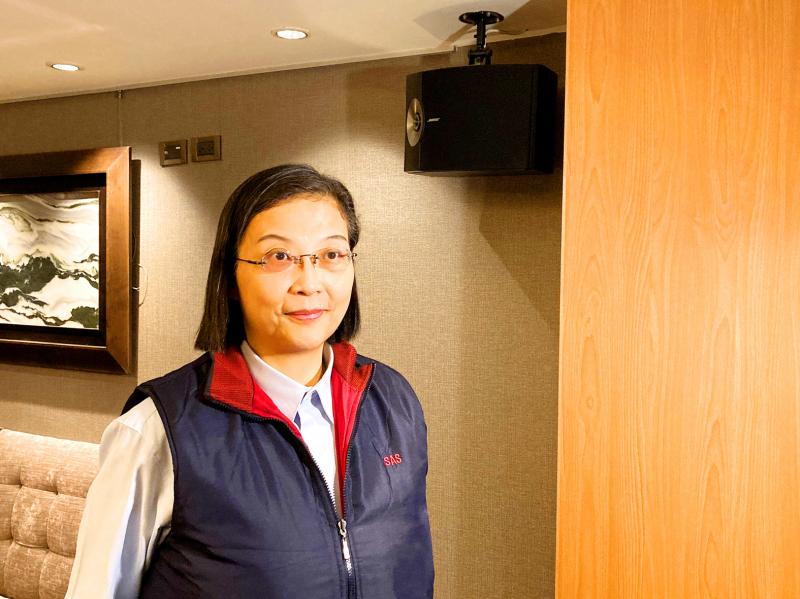GlobalWafers Co (環球晶圓), the world’s No. 3 silicon wafer supplier, on Monday said that it is to raise its prices next year as 5G-related applications and the stay-at-home economy have boosted semiconductor demand during the COVID-19 pandemic, leading to supply constraints.
With limited new supply worldwide, demand is expected to rise to the peak hit in 2018, the Hsinchu-based company said.
GlobalWafers expects to produce an additional 170,000 wafers a month next year as its new 12-inch fab in South Korea is increasing production.

Photo: Lisa Wang, Taipei Times
“We expect the new South Korea fab to reach full capacity next year. We fear we will not be able to supply as many [wafers] as customers have requested,” chairwoman Doris Hsu (徐秀蘭) told reporters at a media gathering in Taipei.
All of the company’s production lines are approaching full capacity and will remain so in the first half of next year, she said.
GlobalWafers is to raise the prices of all its wafers, with 12-inch wafers seeing the highest increases, she added.
The price increases would help hold the average selling price steady next year as some long-term contracts expire, Hsu said, adding that the multi-year contracts usually carry a higher average selling price.
The company is also increasing prices to help absorb volatility on the foreign exchange market, she said, as a strong New Taiwan dollar has eroded profits so far this year.
GlobalWafers expects strong demand to bring its annual revenue next year close to 2018’s record high of NT$59.06 billion (US$2.07 billion).
That forecast does not factor in the acquisition of Siltronic AG. The deal is expected to add NT$45 billion per year to revenue upon completion of the transaction in the second half of next year at the earliest.
“This year is quite a good year for us. As we estimated earlier this year, [revenue] has grown each quarter on a quarterly basis,” Hsu said. “Next year will be better than this year.”
Revenue growth should be expected in each quarter next year, she said.
The pandemic has increased demand for networking equipment, remote education, videoconferencing and online gaming, as well as 5G-enabled smartphones, Hsu said, adding that a global move online has accelerated because of the pandemic.
Accelerating uptake of 5G technology for autonomous vehicles and other devices would make “2022 an even better year,” Hsu said.

Taiwan Semiconductor Manufacturing Co (TSMC, 台積電) last week recorded an increase in the number of shareholders to the highest in almost eight months, despite its share price falling 3.38 percent from the previous week, Taiwan Stock Exchange data released on Saturday showed. As of Friday, TSMC had 1.88 million shareholders, the most since the week of April 25 and an increase of 31,870 from the previous week, the data showed. The number of shareholders jumped despite a drop of NT$50 (US$1.59), or 3.38 percent, in TSMC’s share price from a week earlier to NT$1,430, as investors took profits from their earlier gains

AI TALENT: No financial details were released about the deal, in which top Groq executives, including its CEO, would join Nvidia to help advance the technology Nvidia Corp has agreed to a licensing deal with artificial intelligence (AI) start-up Groq, furthering its investments in companies connected to the AI boom and gaining the right to add a new type of technology to its products. The world’s largest publicly traded company has paid for the right to use Groq’s technology and is to integrate its chip design into future products. Some of the start-up’s executives are leaving to join Nvidia to help with that effort, the companies said. Groq would continue as an independent company with a new chief executive, it said on Wednesday in a post on its Web

CHINA RIVAL: The chips are positioned to compete with Nvidia’s Hopper and Blackwell products and would enable clusters connecting more than 100,000 chips Moore Threads Technology Co (摩爾線程) introduced a new generation of chips aimed at reducing artificial intelligence (AI) developers’ dependence on Nvidia Corp’s hardware, just weeks after pulling off one of the most successful Chinese initial public offerings (IPOs) in years. “These products will significantly enhance world-class computing speed and capabilities that all developers aspire to,” Moore Threads CEO Zhang Jianzhong (張建中), a former Nvidia executive, said on Saturday at a company event in Beijing. “We hope they can meet the needs of more developers in China so that you no longer need to wait for advanced foreign products.” Chinese chipmakers are in

POLICY REVERSAL: The decision to allow sales of Nvidia’s H200 chips to China came after years of tightening controls and has drawn objections among some Republicans US House Republicans are calling for arms-sale-style congressional oversight of artificial intelligence (AI) chip exports as US President Donald Trump’s administration moves to approve licenses for Nvidia Corp to ship its H200 processor to China. US Representative Brian Mast, the Republican chairman of the US House Committee on Foreign Affairs, which oversees export controls, on Friday introduced a bill dubbed the AI Overwatch Act that would require the US Congress to be notified of AI chips sales to adversaries. Any processors equal to or higher in capabilities than Nvidia’s H20 would be subject to oversight, the draft bill says. Lawmakers would have